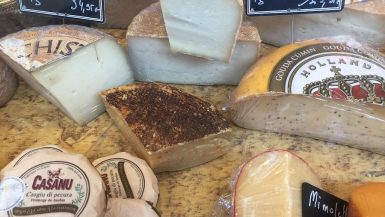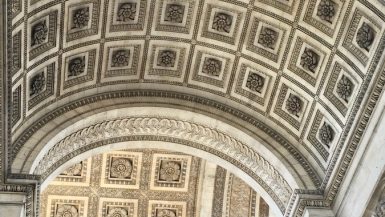October 30, 2017
Note: The most important thing I have to say today is that I have the most wonderful and kind husband in the world. Sixteen years ago today, I married my best friend and the one I love with all my heart. He’s loved me through thick and thin, good times and bad, and didn’t flinch when I said that I wanted to travel to Europe for a month. Although he’s undergone criticism from some folks about how he could “let me” travel without him, he’s handled those people with grace and continued to be supportive of my travels. Steven, I love you to the moon and back – you are my life and my love. Happy Anniversary!
My 5:30 a.m. wake-up call was not welcome this morning. It seemed to come too early. Luckily, I’d laid out everything I needed late night, so I could sleepwalk through getting ready. The day was crisp and clear. There were more people and cars on the road, so my walk to the pickup spot was not as eerie as yesterday. The bus wasn’t a big as yesterday’s and was pretty packed, but I scored a seat in the last row by myself so I could spread out.
Almost everyone fell asleep as we hit the highway toward Chambord, our first castle/château of the morning.
Chambord was built by King Francois I nearly 600 years ago in an early Renaissance style and then finished to some extent by the Sun King, Louis XIV. It is virtually empty because the furniture was auctioned off during the French Revolution, but it has so many lovely rooms. Its most notable feature is the double helix staircase believed to have been designed by Leonardo da Vinci. It consists of two separate flights of stairs – two people climbing the separate staircases could catch glimpses of each other through holes in the center, but never meet.
Leonardo died before the staircases were built. [Side note: although there is a legend that Leonardo died in the arms of Francois I, it cannot be true. Written records establish Francois I was in Italy at the time of Leonardo’s death. Additionally, although there are rumors of a romantic relationship between Francois and Leonardo, it is only gossip. It is believed Francois I thought of Leonardo as a father figure because his own father died when he was two years of age.]

As the palace was built for the pleasure and glory of the king (at the time), hundreds of salamanders (his logo) and crowned sculpted “F” letters are emblazoned on the walls, floors, doors, and ceilings.

Unfortunately, I didn’t have much time to explore the gardens before the bus left, but it would have been pleasant as it was a bright, sunny day.
The next chateau was Chenonceau, a castle envisioned by and designed for women. Although there was a small Château on the River Cher, Diane de Poitiers, the mistress (or “favorite lady” if you don’t like the term mistress) of King Henry II, was the catalyst behind what is now a very feminine chateau. King Henry II gave Chenonceau to her in 1547. She added the bridge onto the castle, which spans the river. She also created gardens, which were among some of the most spectacular at the time. It was Catherine de’ Medici, however, who made Chenonceau what it is today.
This is a picture of Diane, the King’s “favorite” lady.

This is a picture of Catherine de’ Medici.

I’m sure she wasn’t very happy with whoever painted her portrait. She wasn’t shown in a very favorable light.
As King Henry II’s widow, Catherine de’ Medici ousted Diane from the chateau, made the gardens even more magnificent, and built a two floored gallery on top of the bridge in which to have fabulous galas. Catherine de’ Medici, as Regent, also governed France from the Green Study at the chateau. Don’t worry, Diane got her own fair-sized castle down the river a few kilometers.
Throughout the chateau, you can see the marks of Henry II (a big H) and Catherine de’ Medici (forward and backward C’s that are intertwined – it is said Chanel copied her logo from Catherine’s). However, you can also see marks of Catherine de’ Medici superimposed on Henry II’s which, if you look at it closely, seems to make the letter D, which was Diane de Poitiers’ mark. If I were Catherine, I wouldn’t have been too happy having the mark of my husband’s “favorite lady” in my house.
I liked Chenonceau. We had the most time to explore here, including time for lunch in the cafeteria (pretty decent food). There was beauty inside and outside the chateau, as the grounds are fabulous as well. All of the flower arrangements and live decorations (gourds, leaves, etc.) located inside the chateau come from its gardens and surrounding areas and are changed every couple of days. There were so many floral arrangements that the castle didn’t smell musty or dank like others had. It smelled like a spring day (in autumn) ~ so many intertwining fragrances. It definitely showed that this was a woman’s chateau!
The last chateau on our tour was Cheverny, which was built in a Classical style in the 17th century. The castle is privately owned. The Huraults, within whose family the chateau has been for centuries, still reside in one wing. The chateau slipped out of the Hurault family once in the 16th century when Diane de Poitiers (Henry II’s favorite) bought it while she supervised the renovation of her “new” castle at Chaumont sur Loine when Catherine de’ Medici kicked her out of Chenonceau. The Hurault family lost it again in the 18th century when the heirs lost interest in their inheritance ~ silly people.
The gentleman of the house (the Marquis de Vibraye) was at the door to greet us and take our tickets – he’s very hand’s on. There is an ongoing renovation to the exterior, so, unfortunately, scaffolding and a crane marred many of my photographs.
All the rooms are sumptuously decorated as they would have been in days of yore. The tapestries, the paintings, and the furniture were spectacular. Unfortunately, some of the rooms were dressed down by the current exhibition of legos for the enjoyment of children visiting the chateau. Can you find the four items made of legos in the below picture of the children’s playroom?
I could have spent several more hours at Cheverny. I didn’t get as close a look at the gardens and wooded areas as I would have liked, nor did I get to visit kennels which house a hundred French hounds used for hunting.

While waiting for the bus to navigate the narrow streets of the town to pick us up, I went into the little town church. It had several lovely stained glass windows and a beautiful statue of Mary. I love peeking into neighborhood churches wherever I go.
The trip back to Paris was long (about 3 hours) particularly since we hit major traffic coming back into the city. While walking back from the drop-off point, I found that I was totally relaxed navigating around the city by myself. I was familiar with the streets and felt more like a local even though I don’t smoke and haven’t mastered the no-eye-contact thing.
Since I had a more substantial lunch, I even ate dinner like a Parisien, just stopping by the local Brioche Doree to pick up a small sandwich and a pastry on my way. They spoke to me in French, I responded in French, and she counted out my change in French. I guess my 4% fluency is paying off.









































